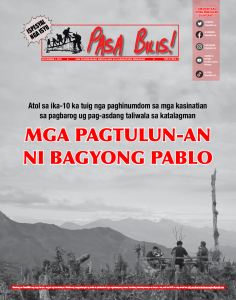by Delilah Mirabal We don’t need a typhoon to build our municipality

Hinterlands of Compostela Valley —“How do we build the people’s government in the municipality level? Maybe we need a typhoon as strong as Pablo!”
This was the running joke during the formal establishment of the Revolutionary Committee in the Municipal level or KRM within an area of contiguous consolidated barrios in the countryside of Compostela Valley [Davao de Oro—Ed.]—all rampaged by Typhoon Pablo. Although the typhoon did indeed present a favorable condition for the masses to tap into their strong unity in overcoming the challenges of the disaster, there was a deeper historical basis why the Party launched a campaign to establish local organs of political power.
“We have managed our communities by ourselves for the longest time. I think it’s time we build our own government,” Tay Biyong said, the chairman of the mass organization of farmers.
“A breakthrough. When we strive to become trailblazers in doing what has never been done before for others to emulate and learn from,” the secretary of the Party section added.
“We just need to review the principles of OPGK (organs of political power of the people), the Guide to Building the People’s Democratic Government and other important documents, and learn and troubleshoot problems in the process.”
The breakthrough of building the KRM became a reality for the Party branch and the NPA unit. Cadres and mass activists from the Party’s Sub-Section, from the subregional urban unit, the newly-established Subregional Peasant Bureau, and the Subregional Guerilla Unit, the vertical unit of the NPA in the area, were mobilized for the campaign. It covered 12 contiguous standard barrios with a population of more or less 12,000.
Solid organizing, production, and strengthening the people’s militia as foundations of the campaign
First of all, the local barrio revolutionary committees or KRB and the mass organizations must be strengthened, for this is where the power of our government comes from. Because these areas have long been guerilla bases and were never destroyed by the enemy, unifying the masses and formally establishing each KRB and solid mass organization (HOM) became easy. In four months, four new KRBs were added to the already existing two KRBs.
“All in all, we have six KRB-level, three HOM-level, and two organizing committee-level (KTO) level barrios. The KRM must ensure that the KRBs function as organs of political power and that the other barrios are developed with the aim of eventually turning them into KRBs as well,” Tay Biyong summarized at the start of the campaign.
“Let’s look again at the basis of our campaign: we have all the needed requisites in building a municipality. We have a strong core of Party cadres from the masses; we have contiguous guerilla bases that have never been destroyed by the enemy; we mobilize thousands during mass campaigns; we are a wellspring of cadres and Red fighters in the Party and the NPA. We have seen again the people’s militance and revolutionary spirit during and after the typhoon. What reason is there to delay the establishment of our government?”
“That’s right,” one comrade said. “We tailed a little from the conditions… a bit conservative.” Heads nodded in agreement.
The KRM needed to have a program to address the basic need for food in their barrios.
“Production and more production!” exclaimed Tay Tonying, pointing to the fresh sprouts of planted corn in the wide field that was damaged by typhoon Pablo.
After the storm, the masses and the comrades strove to rehabilitate the farms as the Party pooled resources for farm inputs, seedlings, and food subsidy for work. Ten months later, seven barrios opened communal farms and around 150 hectares of individual corn and rice fields.
One of the barrios opened a communal vegetable farm for the masses’ consumption, while the surplus yield was sold in the nearest town for additional income for the community. Another barrio opened a rice field of almost 50 hectares.
The collective production campaign was planned during a conference after the typhoon. During the conference, the masses agreed to avoid using chemical pesticides and fertilizers. To control infestation, they were trained to create organic pesticides made from leaves, weeds, and plant roots. Five barrios have their respective tree nurseries for reforestation. As of now, they have more than a thousand seedlings of fruit and durable trees. Other barrios also planted bamboo and other trees.
For the NPA unit, the Red fighters’ own effort in production work became a learning experience. More than two hectares of corn field in one barrio and more than one hectare in another were cultivated by Red fighters themselves in June and July.
“Let’s not forget the schools we rebuilt, the water systems, poultry houses, fishponds, and other services we carried out inside the base,” Kas Mon added, a member of subregional urban unit.
To complete the requisites of building a municipality, the militia on the municipality level was formally established,” reported Kas Bong. “We now have enough strength to advance the guerilla warfare of the masses. Because it is municipality-wide, it is more coordinated and in a better capacity to launch tactical offensives against the enemy.”
As of now, the militia is battalion-sized, whose leading cadres have completed the Basic Politico-Military Course, and Ordnance and Medical trainings. Some of the militia have firsthand combat experience on tactical offensives and have been actively doing tour-of-duty inside regular NPA units for a long time.
‘Done… but not finished yet.’
The KRM was formally established in a conference participated in by representatives from the local Party branches and section, municipal-level HOMs, KRBs, barrio-level HOMs and KTOs, and the municipal-level people’s militia. At the conference, the masses elected their chairperson, vice-chairperson, and the municipal council. The elected officials also appointed the heads and members of the committees on Organization, Education, Economy, Health, and Defense.
The KRM likewise outlined the plans and programs for each committee and the initial important policies.
“That was it, Kas? The preparation and completion of the requisites were much more tiring than the founding day itself,” observed Nay Ida after the conference. But the comrades and the masses knew better, because the KRM’s succeeding months and years will be more complicated in ensuring that the people’s organ of political power functions well.
“Training mass activists to manage the municipality and gradually turning-over to them the important tasks is certainly meticulous, especially that sometimes there is a tendency for the masses to depend on the Party and the NPA.”
“That’s why it seems we’re done,” said a chuckling Tay Biyong, “but we’re actually not finished yet.”
Summing up the lessons in line with our principles
During the campaign, leading cadres overcame a lot of weaknesses and limitations. For Kas Lot, platoon commander of the NPA unit, he learned to be flexible in balancing the basis of solid organizing.
“Before, our understanding of step-by-step organizing is really mechanical. Even though the masses already have a high level of political consciousness and are ripe for the establishment of a higher level of organization, we chose to always begin in step one and drag their development on to the next level.”
In general, the campaign showed that when comrades undertake a comprehensive plan on mass work, we can overcome the vestiges of conservatism and be able to mobilize the masses in their thousands in many barrios.
When we take to heart the Party’s directive to complete the requisites towards strategic stalemate as firm command, our creativity and determination will shine through. Hundreds of Party members, thousands of organized masses and Red fighters exhibited this when the KRM was built.
And so, how do we build the people’s government on a municipal level? In a pot, bring to a simmer the fiery unity of masses and toss in the three requisites of the people’s war. Stoke the fire with the creative vigor of the Red army and stir with the Party’s initiative whenever needed.
“And we really don’t need a strong typhoon to build our municipality,” said Nanay Ida, chuckling.
___
First published in Pasa Bilis! March 2014 issue
(Pasa Bilis! Special Issue, December 4, 2022)



